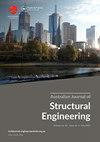Testing the applicability of design code provisions - case of unconventional shear reinforcement
IF 1.3
Q4 ENGINEERING, CIVIL
Australian Journal of Structural Engineering
Pub Date : 2021-07-29
DOI:10.1080/13287982.2021.1958507
引用次数: 0
Abstract
ABSTRACT Common transverse reinforcement of reinforced concrete members with circular cross-section consists of round ties or spirals. Its purpose in members that are not subjected to significant shear loading is to provide proper confinement for concrete, and eliminate buckling of the longitudinal reinforcement bars. If spirals are to be used as both shear enabler and confiner for reinforced concrete beams, then under combined action of moment and shear, spirals will be required to provide or contribute to proper shear resistance. Hence a proper assessment for spiral shear contribution is required. The validity of concepts which underlines current methods for shear design used in design codes will be investigated in this paper especially for beams with the shear configuration used, which violates basic code rules in truss formation. A simplified model based on sectional crack analysis for assessing spiral shear contribution is proposed for practical design consideration.检验设计规范规定的适用性。非常规抗剪加固实例
一般圆形截面钢筋混凝土构件的横向配筋由圆扣或螺旋组成。在不受显著剪切载荷的构件中,其目的是为混凝土提供适当的约束,并消除纵向钢筋的屈曲。如果螺旋既用作钢筋混凝土梁的抗剪促进器,又用作约束器,那么在弯矩和剪力的共同作用下,螺旋将需要提供或有助于适当的抗剪能力。因此,需要对螺旋剪切的贡献进行适当的评估。本文将研究现行设计规范中剪力设计方法中所强调的概念的有效性,特别是对于采用剪力结构的梁,它违反了桁架结构的基本规范规则。提出了一种基于截面裂纹分析的螺旋剪切贡献评估简化模型,以供实际设计参考。
本文章由计算机程序翻译,如有差异,请以英文原文为准。
求助全文
约1分钟内获得全文
求助全文
来源期刊

Australian Journal of Structural Engineering
ENGINEERING, CIVIL-
CiteScore
2.50
自引率
0.00%
发文量
31
期刊介绍:
The Australian Journal of Structural Engineering (AJSE) is published under the auspices of the Structural College Board of Engineers Australia. It fulfils part of the Board''s mission for Continuing Professional Development. The journal also offers a means for exchange and interaction of scientific and professional issues and technical developments. The journal is open to members and non-members of Engineers Australia. Original papers on research and development (Technical Papers) and professional matters and achievements (Professional Papers) in all areas relevant to the science, art and practice of structural engineering are considered for possible publication. All papers and technical notes are peer-reviewed. The fundamental criterion for acceptance for publication is the intellectual and professional value of the contribution. Occasionally, papers previously published in essentially the same form elsewhere may be considered for publication. In this case acknowledgement to prior publication must be included in a footnote on page one of the manuscript. These papers are peer-reviewed as new submissions. The length of acceptable contributions typically should not exceed 4,000 to 5,000 word equivalents. Longer manuscripts may be considered at the discretion of the Editor. Technical Notes typically should not exceed about 1,000 word equivalents. Discussions on a Paper or Note published in the AJSE are welcomed. Discussions must address significant matters related to the content of a Paper or Technical Note and may include supplementary and critical comments and questions regarding content.
 求助内容:
求助内容: 应助结果提醒方式:
应助结果提醒方式:


